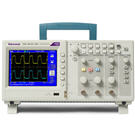The TDS1000C-EDU education oscilloscope series is designed specifically to meet the needs of today's schools and universities. Packed with features and built-in tools, it is easy to learn and simple to operate – ideal for first-time oscilloscope users and students. Featuring the same user interface as other members of the Tektronix TDS Oscilloscope Family, your students will learn to operate the world's most popular oscilloscope platform.

Ảnh chụp bitmap USB

Giao tiếp với máy vi tính
|
Characteristic |
TDS1001C-EDU |
TDS1002C-EDU |
TDS1012C-EDU |
|---|---|---|---|
|
Display (QVGA) |
Color TFT |
Color TFT |
Color TFT |
|
Bandwidth*1 |
40 MHz |
60 MHz |
100 MHz |
|
Channels |
2 |
2 |
2 |
|
External Trigger Input |
Included on all models |
||
|
Sample Rate on each Channel |
500 MS/s |
1.0 GS/s |
1.0 GS/s |
|
Record Length |
2.5k points at all time bases on all models |
||
|
Vertical Resolution |
8 bits |
||
|
Vertical Sensitivity |
2 mV to 5 V/div on all models with calibrated fine adjustment |
||
|
DC Vertical Accuracy |
±3% on all models |
||
|
Vertical Zoom |
Vertically expand or compress a live or stopped waveform |
||
|
Maximum Input Voltage |
300 VRMS CAT II; derated at 20 dB/decade above 100 kHz to 13 Vp-p AC at 3 MHz |
||
|
Position Range |
2 mV to 200 mV/div +2 V; >200 mV to 5 V/div +50 V |
||
|
Bandwidth Limit |
20 MHz for all models |
||
|
Input Coupling |
AC, DC, GND on all models |
||
|
Input Impedance |
1 MΩ in parallel with 20 pF |
||
|
Time Base Range |
5 ns to 50 s/div |
5 ns to 50 s/div |
5 ns to 50 s/div |
|
Time Base Accuracy |
50 ppm |
||
|
Horizontal Zoom |
Horizontally expand or compress a live or stopped waveform |
||
